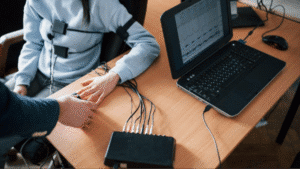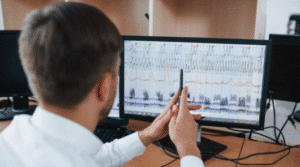The credibility of polygraph exams remains a highly divisive matter. Not only within the technique’s scientific community, but across different cultures too.
Many polygraph advocates are happy to heap accolades on the practice. According to proponents, lie detector tests can support other pieces of evidence to bring guilty suspects to justice and exonerate innocent individuals.
But on the other end of the spectrum lie fierce polygraph critics. Most opponents of the technique readily dismiss it as a sheer waste of time, often citing the existence of many other reliable lie detection technologies.
EyeDetect is one of the most commonly floated polygraph alternatives.
But how effective is EyeDetect at sniffing out liars, and can it truly replace the polygraph?
Let’s find out.
Introducing EyeDetect
The polygraph is perhaps the most common lie detection tool, largely due to its high accuracy score. According to the American Polygraph Association (APA), a single-issue lie detector test administered following the laid-down protocols can achieve up to 95% accuracy.
Expectedly, polygraph critics have severely challenged these benchmarks. Many have gone as far as to encourage alternative techniques like EyeDetect.
EyeDetect is a lie detection technology that uses computerized eye-tracking software to monitor involuntary eye behaviors associated with deception. The technique commonly measures pupil dilation, blink rate, and other eye movements.
EyeDetect borrows from the principle that lying exerts more cognitive load on the brain. This induces physiological stress responses, some of which present as subtle involuntary eye movements. Like many lie detection techniques, EyeDetect is founded on solid science. Earlier studies have shown that lying can trigger eye movements beyond the subject’s control.
How Does EyeDetect Work?
EyeDetect is a non-intrusive technology.
To perform the test, an examinee sits on a computer station and rests their chin on a dedicated platform. They then answer a series of True or False questions as truthfully as possible.
High-definition cameras or optical scanners analyze the subject’s eye movements in response to each question. As this happens, a sophisticated algorithm transmits the information to a web server.
The test ends with the server analyzing the received data. All scoring happens automatically, minimizing human interference.

EyeDetect Benefits
One of EyeDetect’s standout benefits is its non-intrusive nature. Unlike the polygraph, this procedure doesn’t require pinning sensors or attachments to an examinee’s body. Many proponents claim this might minimize in-test anxiety and improve the test’s outcome.
EyeDetect also relies on automated scoring. Sophisticated algorithms score the received data automatically, potentially reducing examiner error and bias.
Moreover, EyeDetect proponents laud the fact that the exam takes a few minutes to administer. While polygraph tests may last up to 2.5 hours to complete, EyeDetect typically takes 15 – 30 minutes.
Can EyeDetect Replace Polygraph Tests?
Polygraph anxiety is a serious concern for industry players.
Typically, the nervousness comes from inadequate examinee preparation. But it may also result from the act of pinning sensors to the subject’s body.
EyeDetect’s non-intrusive nature makes it potentially more desirable for overly anxious examinees. However, that would only make sense if the subject is sufficiently prepared ahead of the test.
Working with a licensed examiner can minimize general polygraph nervousness by familiarizing the examinee with the testing procedure in advance. Part of the preparation entails informing the subject on;
- What to eat
- How to dress
- Drugs to avoid
- How many hours to sleep
- Significance of honesty
It’s also worth noting that normal polygraph anxiety cannot alter the accuracy of a well-administered test. That’s because the technique primarily targets physiological, not mental arousal.

Here are other ways polygraphs excel EyeDetect;
a) Minimal Error Rate
EyeDetect has an average accuracy score of 86 – 88%.
In contrast, single-issue lie detector tests can be up to 93 – 95% accurate.
Where your name or reputation is on the line, a 12 – 14% error rate is simply too high.
b) Higher-quality Data
EyeDetect doesn’t involve interviews. Instead, examinees use a computer mouse to reply True or False to predesigned questions.
Polygraphs involve robust examiner-examinee interviews. These direct engagements can help clear ambiguous terms, improving the test’s accuracy.
Besides, the pre-test and post-test phases of polygraph tests allow for explanations. Examinees can ask critical questions to understand the procedure better or explain some of their responses to in-test questions.
c) Human Touch
By automatically scoring a subject’s data on a web server, EyeDetect may appear less time-consuming. Unfortunately, that very approach eliminates human touch.
Modern polygraph machines also leverage computerized software to capture physiological responses to in-test questions. However, a human examiner interprets the data.
This double-pronged approach can improve the test’s outcome significantly.
d) Reliance on More Effectors
EyeDetect relies almost exclusively on cognitive effort to infer deception. The technology is premised on multiple studies indicating that lying exerts more cognitive load.
Now, polygraphs also rely on similar principles.
However, it utilizes many other effectors, like cognitive dissonance, to draw more accurate conclusions.

Complementing Polygraph Tests With Eye Detect
EyeDetect has its standout benefits and glaring drawbacks. But despite its relative efficiency, this technique still pales in comparison to the polygraph.
Polygraph especially stands out for its higher accuracy score, better scoring methodology, and low risk of inconclusive results.
It’s also worth noting that EyeDetect isn’t the only lie detection technique commonly compared with the polygraph. Others include brain imaging technologies (like EEG and fMRI), voice stress analyzers, and cognitive-based methods.
Perhaps the real debate shouldn’t be on which lie detection technology outshines the other. Rather, how can we integrate these techniques into polygraphy to improve each test’s outcome?






